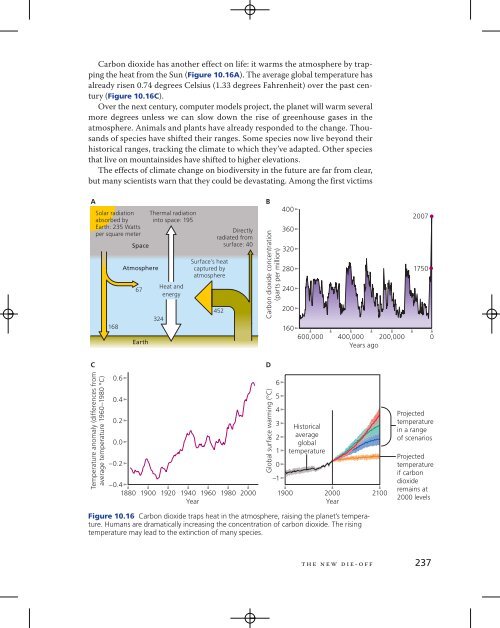Reprinted from The Tangled Bank: An Introduction to Evolution by ...
Reprinted from The Tangled Bank: An Introduction to Evolution by ...
Reprinted from The Tangled Bank: An Introduction to Evolution by ...
Create successful ePaper yourself
Turn your PDF publications into a flip-book with our unique Google optimized e-Paper software.
Carbon dioxide has another effect on life: it warms the atmosphere <strong>by</strong> trapping<br />
the heat <strong>from</strong> the Sun (Figure 10.16A). <strong>The</strong> average global temperature has<br />
already risen 0.74 degrees Celsius (1.33 degrees Fahrenheit) over the past century<br />
(Figure 10.16C).<br />
Over the next century, computer models project, the planet will warm several<br />
more degrees unless we can slow down the rise of greenhouse gases in the<br />
atmosphere. <strong>An</strong>imals and plants have already responded <strong>to</strong> the change. Thousands<br />
of species have shifted their ranges. Some species now live beyond their<br />
his<strong>to</strong>rical ranges, tracking the climate <strong>to</strong> which they’ve adapted. Other species<br />
that live on mountainsides have shifted <strong>to</strong> higher elevations.<br />
<strong>The</strong> effects of climate change on biodiversity in the future are far <strong>from</strong> clear,<br />
but many scientists warn that they could be devastating. Among the first victims<br />
A B<br />
Solar radiation<br />
absorbed <strong>by</strong><br />
Earth: 235 Watts<br />
per square meter<br />
168<br />
Space<br />
Atmosphere<br />
67<br />
Earth<br />
<strong>The</strong>rmal radiation<br />
in<strong>to</strong> space: 195<br />
324<br />
Heat and<br />
energy<br />
Surface’s heat<br />
captured <strong>by</strong><br />
atmosphere<br />
Directly<br />
radiated <strong>from</strong><br />
surface: 40<br />
452<br />
Carbon dioxide concentration<br />
(parts per million)<br />
C D<br />
Temperature anomaly (differences <strong>from</strong><br />
average temperature 1960–1980 °C)<br />
0.6<br />
0.4<br />
0.2<br />
0.0<br />
–0.2<br />
–0.4<br />
1880 1900 1920 1940 1960 1980<br />
Year<br />
2000<br />
Global surface warming (°C)<br />
400<br />
360<br />
320<br />
280<br />
240<br />
200<br />
160<br />
2007<br />
1750<br />
600,000 400,000 200,000 0<br />
Years ago<br />
His<strong>to</strong>rical<br />
average<br />
global<br />
temperature<br />
1900 2000 2100<br />
Year<br />
Figure 10.16 Carbon dioxide traps heat in the atmosphere, raising the planet’s temperature.<br />
Humans are dramatically increasing the concentration of carbon dioxide. <strong>The</strong> rising<br />
temperature may lead <strong>to</strong> the extinction of many species.<br />
6<br />
5<br />
4<br />
3<br />
2<br />
1<br />
0<br />
–1<br />
Projected<br />
temperature<br />
in a range<br />
of scenarios<br />
Projected<br />
temperature<br />
if carbon<br />
dioxide<br />
remains at<br />
2000 levels<br />
the new die-off 237

















